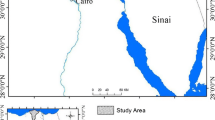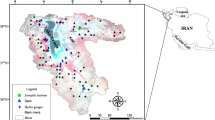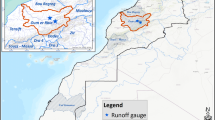Abstract
Understanding water balance components is imperative for proper policy and decision making, specifically in the upper part of the Omo-Gibe basin (UOGB) Ethiopia. The objective of this study is to explore the possibility of assessing consumption and availability of water using freely available satellite data and secondary data. Using twenty-three rain gauge stations data, a spatial average of rainfall was computed using the Thiessen polygon approach. Actual evapotranspiration (ETa) was estimated through the Surface Energy Balance System (SEBS). Input data used are, 16 clouds free Moderate Resolution Imaging Spectroradiometer (MODIS) images covering the study area for estimation of the spatial distribution of actual evapotranspiration covering the whole cropping year from the months of November 2003 to October 2004. Additionally, Priestly and Taylor’s approach was used to estimate reference evapotranspiration (ET0). For the study period, the result of estimated precipitation and ETa showed that the UOGB received 41,080 mm3 of precipitation, while 24,135 mm3 become evapotranspired. The assessed outflow from the basin is 17.6% of the precipitation and demonstrated that water is a scares resource in the UOGB.










Similar content being viewed by others
References
Ahmad M, Biggs T, Turral H, Scott CA (2006) Application of SEBAL approach and MODIS time-series to map vegetation water use patterns in the data-scarce Krishna river basin of India. Water Sci Technol 53:83–90. https://doi.org/10.2166/wst.2006.301
Ahmad MD, Turral H, Nazeer A (2009) Diagnosing irrigation performance and water productivity through satellite remote sensing and secondary data in a large irrigation system of Pakistan. Agric Water Manag 96:551–564. https://doi.org/10.1016/j.agwat.2008.09.017
Akbari M, Toomanian N, Droogers P, Bastiaanssen W, Gieske A (2007) Monitoring irrigation performance in Esfahan, Iran, using NOAA satellite imagery. Agric Water Manag 88(1–3):99–109. https://doi.org/10.1016/j.agwat.2006.10.019
Allen RG, Tasumi M, Morse A, Trezza R, Wright JL, Bastiaanssen W, Robison CW (2007) Satellite-based energy balance for mapping evapotranspiration with internalized calibration (METRIC) - model. J Irrig Drain Eng 133(4):380–394. https://doi.org/10.1061/(ASCE)0733-9437(2007)133:4(395)
Bandara KMPS (2003) Monitoring irrigation performance in Sri Lanka with high-frequency satellite measurements during the dry season. Agric Sci 58:159–170
Bastiaanssen WGM, Ahmad MD, Chemin Y (2002) Satellite surveillance of evaporative depletion across the Indus Basin. Water Resour Res 38(12):9-1–9-9. https://doi.org/10.1029/2001WR000386
Bos MG (2004) Using the depleted fraction to manage the groundwater table in irrigated areas. Irrig Drain Syst 18:201–209
Bos MG (2005) Is there enough freshwater? International Institute for Geo-Information Science and Earth Observation, Enschede, Netherlands, 16 pp
De Fraiture C, Cai X, Rosegrant M, Molden D, Amarasinghe U (2003) Addressing the unanswered questions in global water policy: a methodology framework. Irrig Drain 52(November 2002):21–30
Droogers P, Bastiaanssen W (2002) Irrigation performance using hydrological and remote sensing modeling. J Irrig Drain Eng 128(1):11–18
Hemakumara HM, Chandrapala L, Moene AF (2003) Evapotranspiration fluxes over mixed vegetation areas measured from large aperture scintillometer. Agric Water Manag 58:109–122
Jia L, Su Z, van den Hurk B, Menenti M, Moene A, De Bruin HAR, Cuesta A (2003) Estimation of sensible heat flux using the Surface Energy Balance System (SEBS) and ATSR measurements. Phys Chem Earth 28(1–3):75–88. https://doi.org/10.1016/S1474-7065(03)00009-3
Kurkura M (2011) Water balance of upper awash basin based on satellite-derived data (remote sensing). MSc Thesis, Addis Ababa University 134pp
Matinfar HR, Soorghali M (2014) Estimate evapotranspiration (ET) using SEBS model based on Landsat 5 (TM) thermal data and GIS. Ind J Fund App Life Sci 4(3):30–34
Monteith JL (1981) Evaporation and surface temperature. Q J R Meteorol Soc 107:1–27
Muthuwatta LP, Ahmad MD, Bos MG, Rientjes THM (2010) Assessment of water availability and consumption in the Karkheh river basin, Iran-using remote sensing, and geo-statistics. Water Resour Manag 24(3):459–484. https://doi.org/10.1007/s11269-009-9455-9
Ncube N, Zhakata D, Muchandiona A (2016) Application of a remote sensing technique in estimating evapotranspiration for Nyazvidzi sub-catchment, Zimbabwe. Eur Sci J 12(21):101–115. https://doi.org/10.19044/esj.2016.v12n21p101
Nichols WE, Cuenca RH (1993) Evaluation of the evaporative fraction for parameterization of the surface energy balance. Water Resour Res 29(11):3681–3690. https://doi.org/10.1029/93WR01958
Roerink GJ, Su Z, Menenti M (2000) S-SEBI: a simple remote sensing algorithm to estimate the surface energy balance. Phy Chem Earth, Part B: Hydr Oce Atm 25(2):147–157. https://doi.org/10.1016/S1464-1909(99)00128-8
Rwasoka DT, Gumindoga W, Gwenzi J (2011) Estimation of actual evapotranspiration using the Surface Energy Balance System (SEBS) algorithm in the Upper Manyame catchment in Zimbabwe. Phys Chem Earth 36(14–15):736–746. https://doi.org/10.1016/j.pce.2011.07.035
Samboko H (2016) A remote sensing-based approach to determine evapotranspiration in the Mbire District of Zimbabwe. MSc Thesis, University of Zimbabwe 82pp
Shuttleworth WJ, Gurney RJ, Hsu AY, Ormsby JP (1989) FIFE: the variation in energy partition at surface flux sites. IAHS Publ, 186(6)
Su Z (2002) The Surface Energy Balance System (SEBS) for estimation of turbulent heat fluxes. Hydrol Earth Syst Sci 6(1):85–99. https://doi.org/10.5194/hess-6-85-2002
Su Z, Yacob A, Wen J, Roerink G, He Y, Gao B, Cvan D (2003) Assessing relative soil moisture with remote sensing data: theory, experimental validation, and application to drought monitoring over the North China Plain. Phys Chem Earth 28:89–101. https://doi.org/10.1016/S1474-7065(03)00010-X
Author information
Authors and Affiliations
Corresponding author
Additional information
Responsible Editor: Abdullah M. Al-Amri
Rights and permissions
About this article
Cite this article
Nesru, M., Nagaraj, M.K. & Shetty, A. Assessment of consumption and availability of water in the upper Omo-Gibe basin, Ethiopia. Arab J Geosci 13, 13 (2020). https://doi.org/10.1007/s12517-019-4897-8
Received:
Accepted:
Published:
DOI: https://doi.org/10.1007/s12517-019-4897-8




